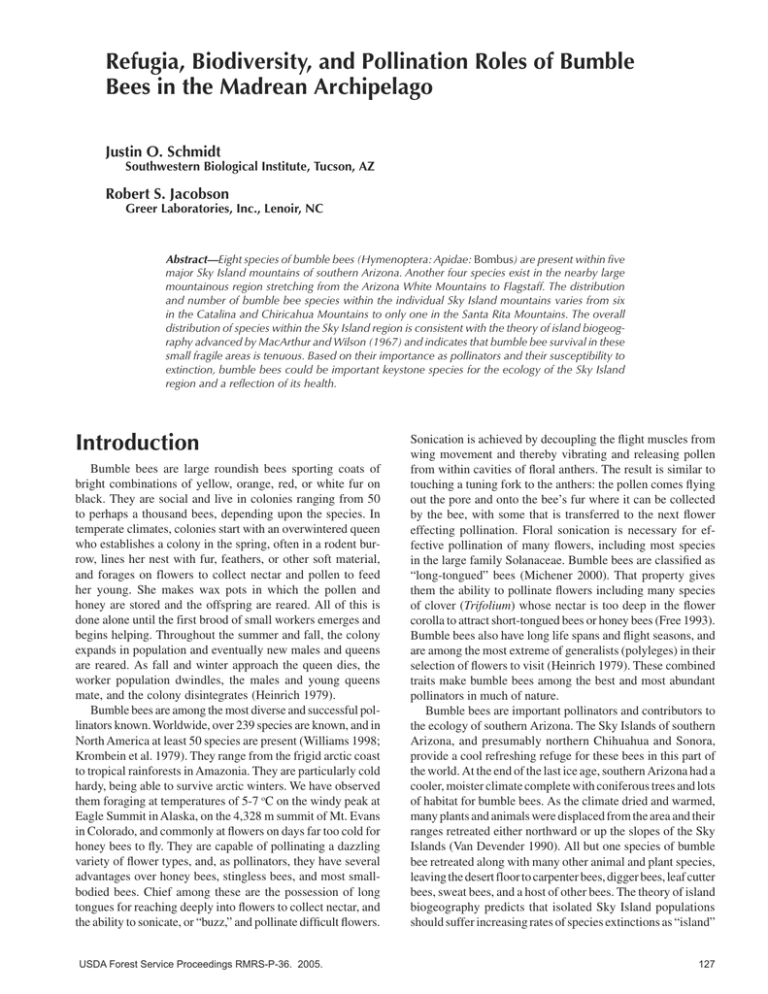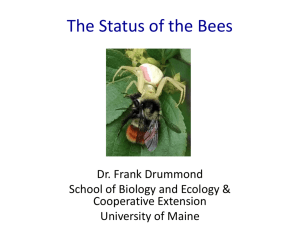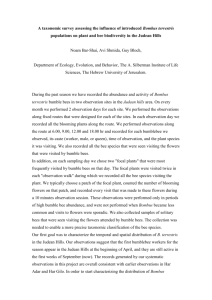Refugia, Biodiversity, and Pollination Roles of Bumble Introduction Justin O. Schmidt
advertisement

Refugia, Biodiversity, and Pollination Roles of Bumble Bees in the Madrean Archipelago Justin O. Schmidt Southwestern Biological Institute, Tucson, AZ Robert S. Jacobson Greer Laboratories, Inc., Lenoir, NC Abstract—Eight species of bumble bees (Hymenoptera: Apidae: Bombus) are present within five major Sky Island mountains of southern Arizona. Another four species exist in the nearby large mountainous region stretching from the Arizona White Mountains to Flagstaff. The distribution and number of bumble bee species within the individual Sky Island mountains varies from six in the Catalina and Chiricahua Mountains to only one in the Santa Rita Mountains. The overall distribution of species within the Sky Island region is consistent with the theory of island biogeography advanced by MacArthur and Wilson (1967) and indicates that bumble bee survival in these small fragile areas is tenuous. Based on their importance as pollinators and their susceptibility to extinction, bumble bees could be important keystone species for the ecology of the Sky Island region and a reflection of its health. Introduction Bumble bees are large roundish bees sporting coats of bright combinations of yellow, orange, red, or white fur on black. They are social and live in colonies ranging from 50 to perhaps a thousand bees, depending upon the species. In temperate climates, colonies start with an overwintered queen who establishes a colony in the spring, often in a rodent burrow, lines her nest with fur, feathers, or other soft material, and forages on flowers to collect nectar and pollen to feed her young. She makes wax pots in which the pollen and honey are stored and the offspring are reared. All of this is done alone until the first brood of small workers emerges and begins helping. Throughout the summer and fall, the colony expands in population and eventually new males and queens are reared. As fall and winter approach the queen dies, the worker population dwindles, the males and young queens mate, and the colony disintegrates (Heinrich 1979). Bumble bees are among the most diverse and successful pollinators known. Worldwide, over 239 species are known, and in North America at least 50 species are present (Williams 1998; Krombein et al. 1979). They range from the frigid arctic coast to tropical rainforests in Amazonia. They are particularly cold hardy, being able to survive arctic winters. We have observed them foraging at temperatures of 5-7 oC on the windy peak at Eagle Summit in Alaska, on the 4,328 m summit of Mt. Evans in Colorado, and commonly at flowers on days far too cold for honey bees to fly. They are capable of pollinating a dazzling variety of flower types, and, as pollinators, they have several advantages over honey bees, stingless bees, and most smallbodied bees. Chief among these are the possession of long tongues for reaching deeply into flowers to collect nectar, and the ability to sonicate, or “buzz,” and pollinate difficult flowers. USDA Forest Service Proceedings RMRS-P-36. 2005. Sonication is achieved by decoupling the flight muscles from wing movement and thereby vibrating and releasing pollen from within cavities of floral anthers. The result is similar to touching a tuning fork to the anthers: the pollen comes flying out the pore and onto the bee’s fur where it can be collected by the bee, with some that is transferred to the next flower effecting pollination. Floral sonication is necessary for effective pollination of many flowers, including most species in the large family Solanaceae. Bumble bees are classified as “long-tongued” bees (Michener 2000). That property gives them the ability to pollinate flowers including many species of clover (Trifolium) whose nectar is too deep in the flower corolla to attract short-tongued bees or honey bees (Free 1993). Bumble bees also have long life spans and flight seasons, and are among the most extreme of generalists (polyleges) in their selection of flowers to visit (Heinrich 1979). These combined traits make bumble bees among the best and most abundant pollinators in much of nature. Bumble bees are important pollinators and contributors to the ecology of southern Arizona. The Sky Islands of southern Arizona, and presumably northern Chihuahua and Sonora, provide a cool refreshing refuge for these bees in this part of the world. At the end of the last ice age, southern Arizona had a cooler, moister climate complete with coniferous trees and lots of habitat for bumble bees. As the climate dried and warmed, many plants and animals were displaced from the area and their ranges retreated either northward or up the slopes of the Sky Islands (Van Devender 1990). All but one species of bumble bee retreated along with many other animal and plant species, leaving the desert floor to carpenter bees, digger bees, leaf cutter bees, sweat bees, and a host of other bees. The theory of island biogeography predicts that isolated Sky Island populations should suffer increasing rates of species extinctions as “island” 127 area decreases, that isolated Sky Islands should accumulate species from adjoining species reservoirs at a rate dependent upon the distance from the reservoir and the dispersal and recolonization abilities of species, and that current species presence on any given island is a reflection of the relative effect of time plus these two forces (MacArthur and Wilson 1967). The purpose of the investigation reported here was to survey the species diversity of bumble bees in the isolated Sky Island mountain ranges of the Madrean Archipelago and to compare the Sky Island bee diversity with the diversity present in the nearby large mountainous reservoir for bumble bees. A goal was to determine if bumble bees might have suffered local extinctions in accord with island biogeography theory and to estimate the likelihood of recolonization of populations lost from the Sky Islands by dispersal of bees from the mountainous region running from the Arizona White Mountains to Flagstaff. Galiuro and Baboquivari Mountains, two other interesting potential ranges, were excluded for two reasons: (1) their highest elevations were somewhat low, around 2,350 m; and (2) access to these areas is difficult. Several methods of survey were used. Over a 10-year period, one of us (JS) conducted numerous collecting trips to these mountain areas to directly survey the bumble bees. In addition, extensive analysis of the insect collections of the Department of Entomology of the University of Arizona and of R. S. Jacobson yielded many good records from both modern collectors and those of the previous century. Finally, literature data and the personal experiences of RJ and Robbin Thorp (Thorp et al. 1983; Thorp, personal communication) completed the search. Identifications were confirmed by one of the authors (RJ) and sometimes also by Robbin Thorp (personal communication). Specimens are placed in the collections of the authors and at the University of Arizona. Materials and Methods Results Isolated mountain areas were considered to be Sky Island refugia for bumble bees if peak mountain elevations were greater than 2,500 m and low points in all surrounding directions were 1,500 m or less. The reason for these criteria is that, with one exception, all bumble bee species require or greatly benefit from the forested relatively moist areas provided by high mountain tops. They do not tend to forage or disperse readily through the drier and warmer more open areas generally present at 1,500 m (personal observations). Moreover, if the peak of a mountain range does not reach at least 2,500 m, the areas around the peak and even the peak itself, generally are not sufficiently high and moist to produce suitable habitat for bumble bees. Five mountain areas in southeastern Arizona met these criteria: the Catalina Mountains (Mt Lemmon, 2,791 m); the Pinaleno Mountains (referred to as the Graham Mountains, Mt. Graham, 3,265 m); the Chiricahua Mountains (Flys Peak, 2,946 m); the Huachuca Mountains (Miller Peak, 2,885 m); and the Santa Rita Mountains (Mt. Wrightson, 2,881 m). The The large contiguous northern mountainous region of the Madrean Archipelago stretching from the Arizona White Mountains along the Mogollon Rim and highlands to Flagstaff contains 10 known species of bumble bees (table 1). All of these species have extensive ranges in nearby areas of California, Utah, Colorado, and New Mexico, and often considerably further north and east in North America (Thorp et al. 1983; Krombein et al. 1979). One species in the table, Bombus sonorus, is absent from the White Mountain-Flagstaff region. This species is generally characterized as being a member of the Mexican fauna and thrives in arid regions of the Chihuahuan and Sonoran Deserts, and in dry, warm areas of southern coastal and central California. This species nests in the lower slopes and desert below the Sky Islands and forages from those areas up to and including the peaks of the Sky Islands. As such, it is the only southern and desert species in the Arizona Madrean area and is not a true inhabitant of the Sky Islands, only a foraging visitor to the islands. Table 1—Bumble bee species present in the mountainous region of Arizona stretching from the White Mountains to Flagstaff and in individual Sky Island Mountains of southern Arizona. Mountains Species Bombus sonorous B. morrisoni B. huntii B. fervidus B. centralis B. melanopygus B. (Ps.) variabilis B. (Ps.) insularis B. occidentalis B. rufocinctus B. flavifrons B. nevadensis 128 Flagstaff—White X X X X X X ? X X X X Catalina Chiricahua Graham Huachuca Santa Rita X X X X X X X X X X X X X X X X X X X X USDA Forest Service Proceedings RMRS-P-36. 2005. The five Sky Islands in table 1 can be loosely categorized two ways—island size, and island position. The Catalina, Graham, and Chiricahua Mountains are large mountains compared to the other two. The Catalina and Graham Mountains are more northerly, and closer to the contiguous northern mountain region than are the other three mountain islands. The Catalina and Chiricahua Mountains each contain 6 species of bumble bees, 5 in common. The Graham Mountains have 4 species, three in common with the Catalinas and Chiricahuas and one unique to that range. The Huachuca Mountains have only 3 species, all in common with those in the Catalinas, Chiricahuas, and Grahams. The Santa Rita Mountains have the fewest species, only one—Bombus sonorus. In a sense, this range has no recorded species that would be expected to nest and inhabit the highest elevations. A key to the species of bumble bees in the Sky Islands of the southern Arizona Madrean Archipelago is presented in figure 1. The key was developed to use minimal scientific terminology and to require only a hand lens at most for seeing sufficient detail for successful identification. It is intended to be ideal for specimens collected in the southeastern Arizona desert or the Sky Islands region and northern Sonora and northwestern Chihuahua. The key might not work as well outside those regions because additional species are likely present and color pattern variation among populations within species becomes a problem. Discussion One of the surprises in this study was the discovery of a species entirely unknown to southern Arizona. This species is the social parasite, Bombus (Psithyrus) insularis. Queens of this species invade colonies of other bumble bee species, displace the original queen, and lay eggs in her place. We had difficulty identifying this unusual bumble bee. Not only had it not been recorded in our area, but also it was very much lighter in color, being almost white-yellow instead of rich yellow and with more areas that are dark, and it possessed much thinner pelage of setae. Its status remains uncertain until more investigations are conducted to determine if the species is a color variation of B. insularis or a new species. At present, eight species of bumble bees are known from the Sky Islands of southern Arizona. These are listed in the table along with their distribution in various mountain ranges. Several observations emerge from these data. Although Bombus sonorus is the only species present in all listed mountain ranges, it would be misleading to assume it is a true Sky Island inhabitant. Rather, it is the one species specifically adapted to life in the desert and lower mountain slopes, and that is typically where it is found. Exceptions do occur—for example, two young queens were caught on the top of Mt Lemmon at the Stewart Observatory on September 28, 1994. These individuals probably had flown there from a lower elevation in an attempt to find flowers still in bloom. Bombus morrisoni is the most widespread of the true Sky Island bumble bees. It is known USDA Forest Service Proceedings RMRS-P-36. 2005. from mid and upper elevations of four ranges. Bombus huntii and B. fervidus are known from two ranges, while three other species, B. centralis, B. (Ps.) variabilis, and B. melanopygus, are each known from only one range. The last species was also a new record for State. Many questions remain. Why are three of the eight species found on only one of the Sky Islands and another two species only on two islands? Could these be the result of random extinction processes operating independently on each Sky Island and on each bumble bee species? The occurrence of local extinctions of species as predicted by island biogeography theory is generally consistent with the overall species distribution. As observed, the larger Sky Islands, the Catalina, Chiricahua, and Graham Mountains, would be expected to have lower extinction rates than the two smaller Sky Islands. Moreover, should an extinction event occur, those Sky Islands nearer the extant populations in the Arizona highland areas would be expected to be the first to be recolonized. Accordingly, the Catalina and Graham Mountains would be expected to be recolonized first. The observation that the Catalina Mountains have the most species (along with the Chiricahua Mountains) fits the prediction, but the somewhat lower species number in the Graham Mountains does not. The Huachuca and Santa Rita Mountains, being both smaller in peak area and more distant from the reservoir of bee populations for recolonizations, would be expected to have the fewest species, in accord with observations. Thus, the Sky Islands of southern Arizona appear to be acting as true islands vis-à-vis bumble bee extinctions and potential recolonizations. They are true, albeit fragile, refugia in the desert for many species of bumble bees, pollinators whose presence or absence could profoundly affect the ecology of entire mountaintops. References Free, John B. 1993. Insect pollination of crop plants. 2d ed. London: Academic. 684 p. Heinrich, Bernd. 1979. Bumblebee economics. Cambridge, MA: Harvard University Press. 245 p. Krombein, Karl V.; Hurd, Paul D., Jr.; Smith, David R.; Burks, B. D. 1979. Catalog of Hymenoptera in America north of Mexico. Washington, DC: Smithsonian Institution Press. 2735 p. MacArthur, Robert H.; Wilson, Edward O. 1967. The theory of island biogeography. Princeton, NJ: Princeton University Press. 203 p. Michener, Charles D., 2000. The bees of the world. Baltimore, MD: Johns Hopkins University Press. 913 p. Thorp, Robbin W.; Horning, Donald S., Jr.; Dunning, Lorry L. 1983. Bumble bees and cockoo bumble bees of California (Hymenoptera: Apidae). Bulletin of the California Insect Survey. 23: 1-79. Van Devender, Thomas R. 1990. Late Quaternary vegetation and climate of the Sonoran Desert, United States and Mexico. In: Betancourt, Julio L.; Van Devender, Thomas R.; Martin, Paul S., eds. Packrat middens the lasts 40,000 years of biotic change. Tucson, AZ: University of Arizona Press: 134-65. Williams, Paul H. 1998. An annotated checklist of bumble bees with an analysis of patterns of description (Hymenoptera: Apidae, Bombini). Bulletin of the Natural History Museum of London (Entomology). 67(1): 79-152. 129 Figure 1—Key to the bumble bees of the Sky Islands. Although the first segment (the propodeum) of the abdomen is fused with the thorax; the remainder of the abdomen forms a unit distinctly hinged to the thorax; this is called the gaster. References to numbered segments in the key indicate those of the gaster from front to back (i.e., the hinged segment is regarded as the first one). Although the exoskeleton of the bee is entirely black, color descriptions refer to the hair. 1a. Gaster having six visible segments; sting present (but often retracted within the rather pointed sixth segment); usually having pollen baskets on the broadened tibia of hind legs ..............................................2 (females) 1b. Gaster having seven visible segments; sting absent; tip of gaster rather blunt; never having pollen baskets .. 110 (males) 2a. Lacking pollen baskets on hind legs .......................................................................................................9 (Bombus Psithyrus)) 2b. Pollen baskets always present ..............................................................................................................3 (nonparasitic Bombus) 3a. Segments two and three of gaster black ...................................................................................Bombus melanopygus Nylander 3b. Segments two and three light colored ....... 4 4a. Segment three orange ................................ 5 4b. Segment three yellowish, similar to all other light-colored segments of gaster .......................................................................6 5a. Segments two and three both orange; segments one and four yellow..................................................... Bombus huntii Greene 5b. Segments three and four both orange (may be faded on senescent specimens); segments one and two yellowish ................................................................................................... Bombus centralis Cresson 6a. Segments one, two and three yellow; segment four black; distinct black band between wings present ........................................................................................................................ Bombus sonorous Say 6b. Coloring otherwise .................................... 7 7a. Segments one, two and part or all of segment three yellow; segment four black; band between wings completely absent ...................................................................................... Bombus morrisoni Cresson 7b. Segments one through four yellow ........... 8 8a. Face with black hair .......................................................................................................................Bombus fervidus (Fabricius) 8b. Face with considerable yellow hair ................................................................................................... Bombus centralis Cresson 9a. At least some yellow hair present on segments four, five and six ...................................Bombus (Psithyrus) insularis (Smith) 9b. Segments four, five and six entirely black ................................................................. Bombus (Psithyrus) variabilis (Cresson) 10a. Segments one and two entirely black; clypeus black ............................................... Bombus (Psithyrus) variabilis (Cresson) 10b. Light hair on at least segment one......... 11 11a. Segment three and most or all of segment two black .............................................................Bombus melanopygus Nylander 11b. Segment three with light hair ................ 12 12a. Segment three orange ............................ 13 12b. Segment three yellowish, similar to all other light-colored segments of gaster ...................................................................14 13a. Segments two and three both orange; segments one and four yellow................................................... Bombus huntii Greene 13b. Segments three and four both orange (may be faded on senescent specimens); segments one and two yellowish ................................................................................................... Bombus centralis Cresson 14a. Segments one through four yellow; segment five black; distinct black band between wings present ........................................................................................................................ Bombus sonorous Say 14b. Coloring otherwise ................................ 15 15a. Segments one through three and anterior part segment four yellow; segment five black; band between wings completely absent; compound eyes enlarged ............................................ Bombus morrisoni Cresson 15b. Segments one through five yellow; compound eyes reduced (i.e., as in females) ................................................................16 16a. Lower part of face (clypeus) extensively yellow............................................................................. Bombus centralis Cresson 16b. Clypeus black or at most with few light hairs .......................................................................................................................17 17a. Top of head (vertex) with yellow hairs when viewed from above ................................Bombus (Psithyrus) insularis (Smith) 17b. Vertex black when viewed from above ........................................................................................Bombus fervidus (Fabricius) 130 USDA Forest Service Proceedings RMRS-P-36. 2005.






